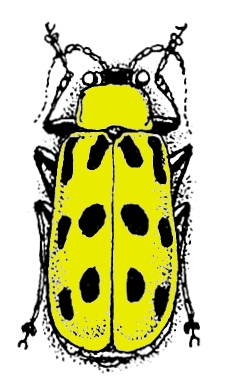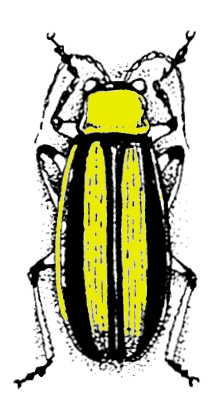Insecticides
Cucumber Beetle Control
 
Cucumber Beetles are approximately 1/4 inch in length
Cucumber Beetles are perhaps the Gourd Growers enemy number 1, and some kind of insect control should be used to
control their numbers, the most common type of insecticides are chemical like Sevin, however we like to steer more toward non chemical
insecticides. Both the spotted and the striped Cucumber Beetles are cousins, and as far as their appetite and damage potential to
gourd crops, they are basically identical. While Cucumber beetles can damage the vines and your gourds, their greatest potential threat is
probably their potential for carrying diseases. The most common threat of disease comes from the Mosaic Virus.
MYTH: Cucumber Beetles are the only insect I have, if I kill them I might not get pollination. This
is simply not true. Cucumber beetles have no pollen hairs ot any other method for transporting pollen from one flower to the next.
Cucumber beetles serve only to damage your plants, and potentially spread disease.
Control of cucumber beetles is difficult at best, and insecticides whlie helping to control the cucumber beetle population,
can also kill your pollinators. The best defense against being completely overtaken by Cucumber Beetles is by using garden tillers in the
fall after harvest and tilling again in the early spring. Cucumber beetles burrow into the ground and lay their eggs there. The eggs
are lighter than the dirt, and running a tiller through the dirt tosses the ground, making it almost fluid momentarily, and the lighter eggs and
larvae get shuffled to the top. Subsequent freezing during the winter time will kill off these lavea. I have found that if you forget
to till in the fall, tilling in the early spring will also kill off most of the new seasons Cucumber beetle population. One season, we
tilled the entire garden to within 6 inches of our trellis. The rest of the garden was planted first, and the plants came up and were
growing great, with no sign of cucumber beetles. After they got started, we planted vines up close to the trellis, and as soon as the
shoots had their baby leaves, Cucumber beetles came out of that small strip of ground and began attacking these new shoots near the trellis, and
did not migrate to the other gourds until they became too populated for the new shoots. This is evidence of how thorough they are at laying
their eggs through out the entire garden, and how critical it is that the entire area get fully tilled. We tried saving a few late starters using
Sevin insecticide, but it burned the saplings to the point they could not produce a viable fruit.
If you do not control this insect population early by using a garden tiller, you run the risk of them coming in from the
previous year in such numbers that your early vines may be in jeopardy and you may not be able to grow decent vines. If you use Sevin
insecticide , (the most commonly used insecticide for cukes), on your early shoots, the Sevin can actually burn the stalk of the vine and stunt
it's growth, making it hard or impossible for the vine to pass food and water to the rest of the vine. This can result in death, or
possibly a stunted vine, most commonly unproductive, however we have grown a few stunted gourds in the process of learning this, but it is not
recommended. :-) It is preferential to use natural methods to control the cuke population, one of our favorites is to grow radishes all
around the area. Let them grow with the vines, cukes hate the spicy vegetable that grows in the ground. Another side effect of Sevin on
gourd vines is it can make your leaves appear to have a mosaic virus by burning the leaves in spots.
If you disturb a cucumber beetle, they don't normally fly away, but rather when they are threatened, they simply fall to the
ground, this is their defensive escape, and cucumber beetles burrow into the ground. Laying down a good ground mulch like straw, hay, or grass
clippings in a good 10 inch thick bedding, this hinders the Cucumber beetles ability to easily reproduce, thus reducing the future
population. Mulch should be taken tight up to the base of the vine.
| 


